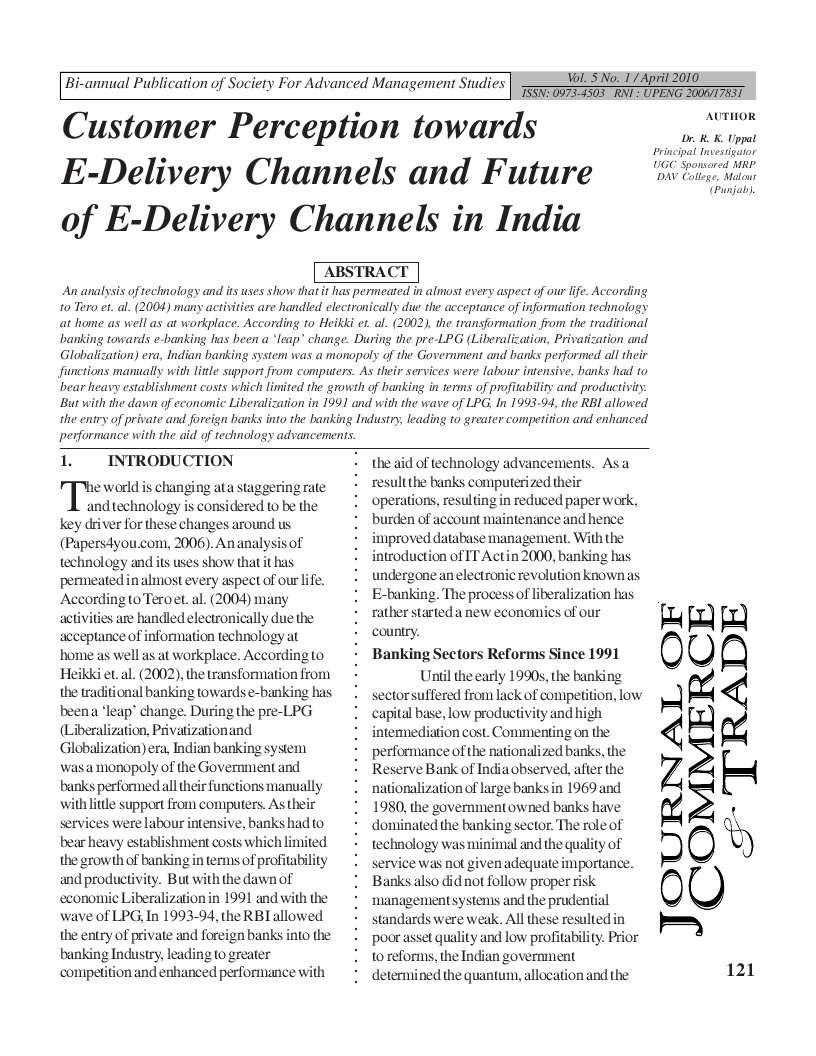Customer Perception towards E-Delivery Channels and Future of E-Delivery Channels in India
DOI:
https://doi.org/10.26703/jct.v5i1.383Keywords:
Customer Perception, E-Delivery, E-Delivery Channels, IndiaAbstract
An analysis of technology and its uses show that it has permeated in almost every aspect of our life. According to Tero et. al. (2004) many activities are handled electronically due the acceptance of information technology at home as well as at workplace. According to Heikki et. al. (2002), the transformation from the traditional banking towards e-banking has been a ‘leap’ change. During the pre-LPG (Liberalization, Privatization and Globalization) era, Indian banking system was a monopoly of the Government and banks performed all their functions manually with little support from computers. As their services were labour intensive, banks had to bear heavy establishment costs which limited the growth of banking in terms of profitability and productivity. But with the dawn of economic Liberalization in 1991 and with the wave of LPG, In 1993-94, the RBI allowed the entry of private and foreign banks into the banking Industry, leading to greater competition and enhanced performance with the aid of technology advancements.
Downloads
References
Akiniserkan, Aksoy Safak and Atilgan Eda (2004) : “Adoption of internet banking among sophisticated consumer segments in an advanced developing country,” International journal of Bank Marketing. Emerau Group Publishing Limited Vol. 22, issue 3 pp. 212-232.
Annual Hawaii International Conference on system Sciences 40th (2007): “Cognition, Emotion, Satisfaction and Post behaviours of E-Service Customers.” Chea, University of Hawaii at Manoa, USA. LUO, Yuan-Ze University Taiwan.
Consumer Voice(2006) : “Banking Sector: India’s First Survey of Customer Satisfaction Study’, Consumer Voice, Vol. 7, Issue 1 (July), pp. 14-20.
Ganesh S. (2000) : “Electronic Commerce: Applications in Banking”. Published Article. IBA Bulletin March 2000. pp. 39-43.
Garg Poonam and Jham Vimi (2006) : “Indian Banks and ATM-An Empirical Study of Consumer Perceptions, Strategies of Winning Organizations”, Ed. By Upinder Dhar, Dhar S. and Chauhan V.S., Excell Books, New Delhi, pp. 516-23.
Google.Com. : An internet web site.
Ibrahim,Joseph and Ibeh (2006) : “International Journal of Bank Marketing.” (2006) Vol.24, Issue 7, pp.475-493.
Jalan, Bimal (2001) : “Banking and Finance in the new millennium”, RBI Bulletin, February, 2001.
Kamakodi and Ahmed (2008) : “International Journal of Electronic Banking.” Issue- Vol.-1, pp.73-94.
Krishna Murali R. (2000) : “Electronic Banking” published Article. IBA Bulletin March. pp. 10-13.
Kukkddi J. and Deene S. (2006) : “Impact of ATMs on Customer Satisfaction (A Case Study of SBH in Gulbarga District of Karnataka)”, Strategies of Winning Organizations, Ed. By Upinder Dhar, Dhar S. and Chauhan V.S., Excell Books, New Delhi, pp. 509-15.
Lim Bee Eng., Chamwoon Hong, Chai Chor Yam, Lee Huilino (1999): “Retail Banking : Impact of Technological innovations on customer satisfaction”. Malaysian and Singapore institute of Management, published Article. Essinger publication, Singapore.
Lee Ladhar, V. (2005) : “Indian Banking - The challenges Ahead”, RBI Bulletin, December. p. 1131.
Madhava Rao K. (1999) : Report of the High power committee on urban co-operative Banks.” Government of India Committee Report. November, 13.
Malhotra A.P. (2000) : “Electronic Banking” published Article. IBA Bulletin March. pp. 16-19.
Mobarek Asma (2005) : “E-banking practices and customer satisfaction - A case study in Botswana”.
Nair S.N (2000) : “E-Commerce and the Emergence of E-Banking”, IBA Bulletin, Vol. 22, No. 10 (October).
Narasimham, M (1998) : “Report of the committee on Banking Sector Reforms”, Government of India Committee Report.
Niranjan (2000) : “Internet Banking is Here”, published Article. Business World. April. p-13.
Olga, Lustsik’ Janek, Uiboupin; Mart sorg; Liuntu, Kari; (2007) : “Organizational and sectoral changes in Transition banking; Estonian Experience’ Frames publication Issue 2/2007 pp 155-172.
Palsokar PV (2000) : “Electronic Banking” published Article. IBA Bulletin March. pp. 14-18.
Prasad Chowdari and Rai Srinivasa K.S. (2005) : “Private Sector Banks in India, published Article. ICFAI university press publication.
Raghavan R.S. : “Perception of Indian Banks in 2020”.
Raja Kumar Dennis J(2005) : “Financial intermediation under Reforms in India: Evidences from scheduled commercial banks”. ICFAI University Press Publication.
Singh Swarn (2000) : “Electronic Banking” published Article. IBA Bulletin March. Pp. 24-27.
Sohail Sadiq M. and Shanmugham Bala Chandran (2002) : “E-banking and customer preferences in Malaysia: An empirical investigation,” Department of Management and Marketing, college of Industrial Management, Saudi Arabia.
Srivastava C(2006): “Customer Relationship Management : A Key success Factor in Services Marketing (A Case Study of Banking Services in India)” , Strategies of Winning Organizations, Ed. By Upinder Dhar, Dhar S. and Chauhan V.S., Excell Books, New Delhi. Pp 481-90.
Uppal R.K. : “Transformation in Banks through e-banking services”.
Uppal R.K. & Jatana Rimpi : “E-banking in India challenges and opportunities”.
Uppal R.K. & Pooja : “E-delivery channels in banks: customer perception”.

Downloads
Published
Issue
Section
License
Copyright (c) 2010 Dr. R. K. Uppal

This work is licensed under a Creative Commons Attribution 4.0 International License.










